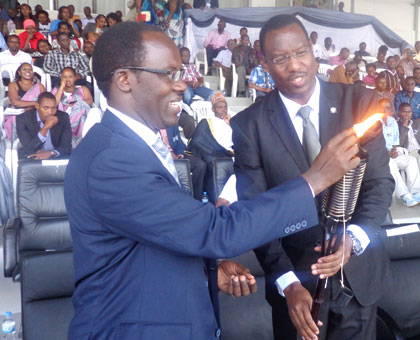The City of Kigali on Friday paid tribute to 34 former staff killed in the 1994 Genocide against the Tutsi. According to testimonies, among the major actors was the then Prefecture de la Ville de Kigali (PVK) prefet Tharcisse Renzaho.


The City of Kigali on Friday paid tribute to 34 former staff killed in the 1994 Genocide against the Tutsi.
According to testimonies, among the major actors was the then Prefecture de la Ville de Kigali (PVK) prefet Tharcisse Renzaho.
Col. Renzaho was convicted and sentenced to life in prison by the International Criminal Tribunal for Rwanda (ICTR) in 2009 for his role in the Genocide.
"The plan to exterminate the Tutsi started in Nyarugenge Commune where members of the Akazu, the hate media and Hutu extremists, were based,” said Tom Ndahiro, a genocide researcher.
Renzaho, as the "Lord Mayor,” who was installed in office with a specific mission, was always the host of the planning meetings, Ndahiro added.
One of the meetings he chaired defined the country’s ‘enemies’, and saw all the Tutsi and some liberal Hutu blacklisted.
"On March 29, 1994, Renzaho met senior officers, including Castar Nsabimana, the then army chief of staff, and decided that ‘civil defence’ was urgent,” said Ndahiro.
Col. Renzaho ordered local leaders to draw a list of reserve forces that would teach the population how to use guns and traditional arms against the "enemy.”
The list was submitted to Nsabimana, who was supposed to provide the technical support including the ammunition.
Nsabimana sent a letter to Augustin Ndindiliyimana, then minister for defence, on April 1, 1994, with the label ‘very confidential,’ informing him that a list of pro-Rwanda Patriotic Front officers and the civilians was being made.
Two days later, Radio Television Libre des Milles Collines (RTLM) announced that an incident was imminent.
And, as if in anticipation, when President Juvenal Habyarimana’s plane was brought down on April 6, 1994, plans to exterminate the Tutsi were put in action.
Col. Renzaho was arrested in 2002 in DR Congo and transferred to ICTR.
The tribunal convicted the former city mayor for for aiding the Genocide and abetting killings of Tutsi at roadblocks in Kigali and at several other gatherings and hideouts.
He was also convicted for murder as a crime against humanity–for ordering and aiding and abetting the killing of Charles, Wilson, and Déglote Rwanga on April 22, 1994, and for his lead responsibility in the killing of Tutsi men forcefully evicted from refugee camps at Cela on April 22, 1994.
Gervais Dusabemungu, who served as an officer in charge of social affairs and enforcement of rulings in the Nyarugenge urban commune from December 1988 until 1992 when he was dismissed by Renzaho, told this paper that indeed the colonel deserved his sentence.
During the Genocide, Dusabemungu, who was in hiding, heard communication from the mayor, calling on people with trucks to bring them to help remove the ‘trash’ (Tutsi bodies scattered in neighbourhoods) and asking people "working” (killing Tutsi) to make sure they do not expose their "work” on the roadside.
Who is Col. Renzaho?
Col. Tharcisse Renzaho was born on July 17, 1944, in Kigarama commune, Kibungo prefecture.
Gervais Dusabemungu, who served in leadership positions between July 1994 and 2004, as Bourgmestre of Nyarugenge Commune and Mayor of Nyamirambo, knows him well.
In an interview with The New Times this week, he said Renzaho was appointed Prefet of Kigali, on October 8, 1990, when Prefecture de la Ville de Kigali replaced Commune Urbaine de Nyarugenge, the name of the capital from 1975.
His assignment included identifying Tutsi and drawing up strategies to kill them, to destabilise the opposition political parties, and to mobilise against the liberation struggle by the Rwanda Patriotic Front.
Among his strategies was to limit the movement of the Tutsi by denying them travel permits. He also auctioned the properties of some city moguls who had fled the crisis in Kigali.
According to Dusabemungu, Renzaho was both the organiser of and buyer at the auction. Among his victims during the auction was Assinapol Rwigara’s tobacco plant.
Renzaho also dismissed several staff, including Domitille Mukantaganzwa (November 1990), the former executive secretary of Gacaca Jurisdictions, who was then director of administration and legal affairs in the city, on ethnic grounds.
The disorder he created was always accompanied by killings of Tutsi, and the refusal of opposition political parties to demonstrate.
Opposition and private media accused Renzaho of making arbitrary decisions and failing to protect civilians. They called on him to resign but his only response was that they were "enemies of the State.”


